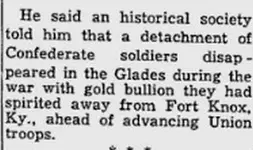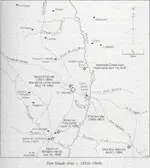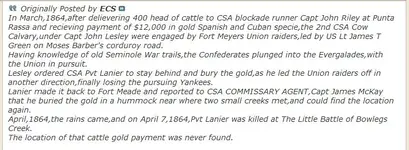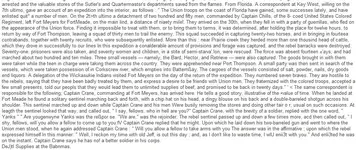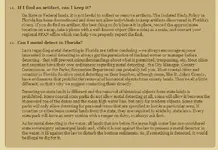It also says the gold vault didnt open until 1937. Surely they must have known this in 1946-49. Or could it be that they just didnt know? It kinda makes the entire story seem suspect.
I had addressed this in an earleir post on this thread.Let us look at this version from a historical point of view,and see how this version evolved.
The Union did occupy Ft Knox during the Civil War,but is was not a gold depository until 1937.
CSA Gen John H Morgan and his cavalry did make raids in that area,and on June 8,1864 raided Mount Sterling,Kentucky,and looted the banks of $140,000 in gold,silver,bank notes,and other currency.It was not shipped to Fort Meade or the Everglades.The Fort Knox mention places this lore from after 1937.
By that time,the Union was successful in cutting off supply lines and trasportation in the South,most ports were blocked by the Union Blockade,and Sherman divided the South with his scorched earth march through Georgia.Remember the railroads at that time did not connect with each other due to different gauges and different owners and routes,so how would the CSA move 1/2 ton of gold through occupied lines from Kentucky to Florida?
It has been mentioned that a 1/2 ton of gold could fit into a cooler.Maybe it could if it were a solid block.How could it be lifted and loaded if that were so?Bars of bullion were placed in wooded crates that could be handled by 2 men,coins most of the time in wooden kegs.So the size of this shipment would larger than a cooler due to its weight.
CSA Capt James McKay was the CSA COMMISSARY AGENT at Fort Meade,and was in charge of all transactions concerning shipping and recieving,payments,etc,and kept good records that still exist in various archives.There is no mention of recieving a 1/2 gold shipment from anywhere or anyone.Fort Meade is located north of the Everglades,and Punta Rassa would have been the logical destination,not going accross the Everglades.
When looking at the historical facts,that version does not pass the test of validity,but makes for a good tale of lore that has become a legend.



